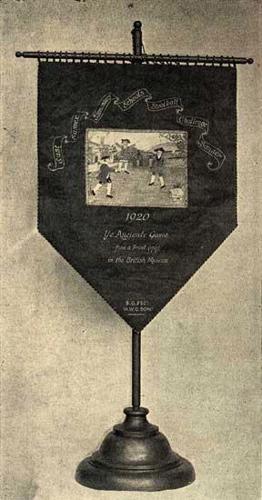'Stoolball in Sussex', by M S Russell-Goggs
Sussex County Magazine published a detailed history of stoolball in its July 1928 edition, which sold for 6d. The article is reproduced here in full.
A point that may quite easily perplex the future historians of Sussex is this: Did Major W W Grantham, soldier and King’s Counsellor (son of the late High Court Judge, Mr Justice Grantham), of Balneath Manor, revive the Sussex round frock, or smock, as a suitable garment in which to disport himself at stoolball, or did he revive stoolball in order to show off his fine smock?
The two revivals stand pre-eminently to his credit, and he is the man to go to if anybody wants to know anything about stoolball or round frocks. His two heavy volumes of press cuttings and data he has collected on the former subject, autographed letters, hundreds of photographs, rules of the game, as altered during last and this century etc, are records that will be invaluable in the years to come.
Other rural districts in England may wish to share with Sussex the glory and honour of the original game of stoolball, but Sussex alone, owing to the enthusiasm of this champion stoolballer, may claim full credit for the 1917 revival, which has resulted in the game being played all over England, and in other countries, including Japan.
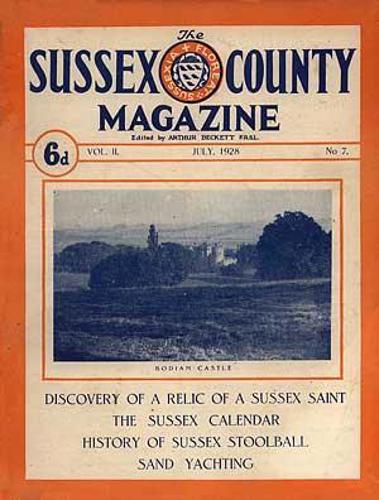
Away back in the dim and distant days of the 15th century people in certain districts had so far fallen from grace as to show a disposition to indulge in Sunday games, and it is largely owing to such delinquents that Mr Grantham, who has followed stoolball through all its vicissitudes, has obtained some of his earliest records of the game.
It was about the year 1450 when Myrc, in his ‘Instructions to Parish Priests’, forbade its being played in churchyards. The game does not require a level ground, as in cricket.
About a century later – 1564 – complaints were made to the justices sitting at the midsummer session at Malden, Surrey, that the constable (himself possibly an enthusiast with the stool and ball) suffered stoolball to be played on Sunday. A few years later, at the Easter Sessions in the same town, one Edward Anderkyn and four others were indicted for playing stoolball on Sunday.
Then there was that godless man of Kent, one “Botolph Wappoll, a continual gamester, and one of very lewd behaviour, who, being on Mayday last at stoolball, in time of divine service, one of our sidesmen came and admonished him to leave off playing and go to church.” The mild rebuke was not received in the spirit in which it was meant, for history relates that this ferocious player “fell upon the sidesman and beat him till blood ran about his ears.”
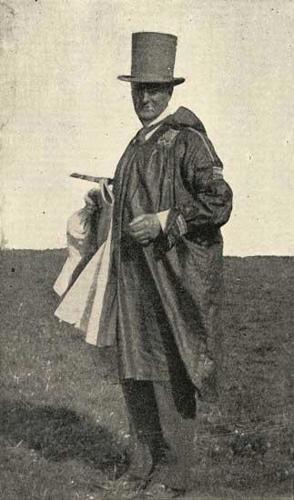
About 1630 a Puritan records that “Maidstone was formerly a very profane town, where stoolball and other games were practised on the Lord’s Day.” This early inclination on the part of Maidstone towards the “Continental Sunday” leads Mr Grantham to suggest that probably none of the prosecutions, nor the assault, would have taken place if the players had gone to church and then enjoyed the game afterwards.
In 1634 – which seems to have been the golden age of stoolball – Archbishop Laud was obsessed by its dangerous popularity. In his visitation and reference to churchÂyards he is troubled because “several spend their time in stoolball.”
Four years later J Smythe, in his Hundred of Berkeley (1640) gave the following admonition: “Doe witness the gentry, veomanry, rascality, boys and children, doe take in a game called stoolball.” Mr Grantham’s comment upon this in a delightful article on the ancient game which he contributed to ‘The Graphic’ in 1923 is that ladies evidently had not taken to the game, unless they were included in the section “rascality.” “J Smythe” had not read his Beaumont and Fletcher, or he would have seen in ‘The Two Noble Kinsmen’, Act V, Scene 2, that the daughter of the jailer says:
“Will you go with me?
What shall we do there, wench?
Why, play at stoolball.”
Robert Herrick, writing about the year 1648, says in his ‘Hesperides’:
“At stool ball, Lucia, let us play
For sugar cakes and wine.”
Neither Lucia nor her companion could be chided for making the stakes too high. In ‘Poor Robin’s Almanac’ (1744) stoolball is referred to:
“Now milkmaids’ pails are deckt with flowers,
And men begin to drink in bowers,
Sweets, sillabub, and lip-loved tansey
For William is prepared by Nancy.
While hobnailed Dick and simpering Frances
Trip it away at country dances,
At stoolball and at barley break
Where they their harmless pastimes make.”
In the 17th century the game had become popular with the fair sex as well as with men and boys. It is reported that William III watched the game soon after he landed at Torbay, and that subsequently Queen Anne was an interested spectator.
Mr Grantham does not go so far as to affirm definitely that this very ancient game was the “bittle battle” mentioned in Doomsday Book, but he is quite convinced that stoolball in some form or other was the progenitor of cricket, rounders and baseball.
Sometimes stoolball is called “cricket up in the air,” as the ball is bowled, not on the ground as originally, at a stool, but, as we all know, at a board a foot square fixed to a post, the top of which board is four feet eight inches above the ground. The wickets are placed 16 yards apart; the bowlers bowl in overs, underhand, 10 yards from each wicket. The bats, which have taken the place of the milking-stools, are similar to enlarged fives bats, and the ball is somewhat smaller and not so hard as a cricket ball. Any fair-sized open space will do for a stoolball field, for the game does not require level ground, as does cricket – hence the sacrilegious use of churchyards in olden times.
Stoolball was played at Chailey in 1861. Major Lionel King, that well-known Sussex sportsman, first saw stoolball in the early ‘sixties, while still a very small boy. He watched the came in a field belonging to Eastfield Lodge, Hassocks, and both men and maidens were playing. His father told him the name of the game and its origin.
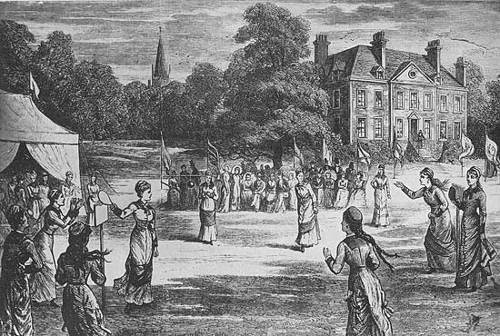
The stoolball match in Horsham Park, seen in the illustration, was played under cricket rules, except that the batsman had to tap the wicket after every ball, whether hit or not, and was out if the wicket-keeper touched the face of the wicket with the ball first.
This Horsham match, it is interesting to hear from the same authority, was between Horsham Park and the Foresters, and the latter team were the victors. Major Lionel King recalls the fact that “while the winners were obviously the better side, the match was spoiled by one incident. Miss Florrie Lucas, of Horsham Park, managed to edge the ball so that it curled round and lodged in her hair, of which she had quite a lot. She asked the wicket-keeper to take it out, which was done, but the Rev C Hodgson, one of the umpires, gave her out “caught,” without having been appealed to. This broke their hearts, and led to “remarks” which nearly ended in play being stopped for good!
The Park team included Miss M Hurst (captain), the Misses B Hurst, F Lucas, F N and E King, H Raynes (sister of Mrs Laurie Thornton), K Sadler (sister of Dudley Sadler, the artist), J and A Reed, and A Oliver. Miss Florrie Lucas (who played stoolball in the unshingled age) was the younger daughter of Mr Charles Lucas, of Warnham. She married Mr Henderson.
The Foresters’ team consisted of Miss Cureton (captain) and her two sisters, who were the nieces of Mr Blore, of Trinity College, Cambridge, the Misses Masters (daughters of the late Canon Masters, who was then Vicar of Lower Beeding, and sisters of Canon Masters, of Speldhurst, and president of the West Kent Stoolball League), the three Miss Graveleys, from Lower Beeding or Cowfold, the two Miss Hodgson, and others. “The Graveleys,” says Major King, “were a very sporting family, for those days, and knew the game backwards.” The umpires were Mr J Ramsden, the Rev C Hodgson, and Mr F Dickins.
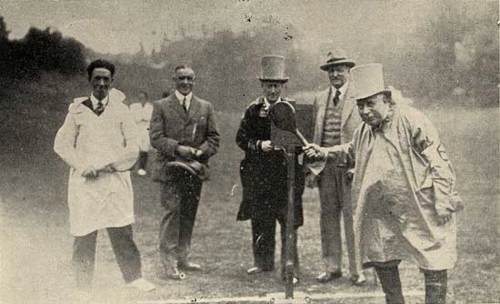
Mr George F Chambers, in his ‘Eastbourne Memories of the Victorian Period, 1845-1901’, speaks of lawn tennis as “a disease which broke out and raged as an epidemic.” “But Sussex,” he adds, “has a game of its own – stoolball – which I am under the impression is, or was, purely a Sussex game, although the following entry respecting it appears in the ‘Imperial Dictionary’: ‘A play at ball, formerly in vogue, especially among young women.’ … Stoolball was much played in and around Eastbourne twenty years ago.”
The late Hon Mrs Campion, of Danny Park, who was captain of the Glynde “Butterflies,” in a letter to Mr Grantham, declared that “Firle was the only village which played stoolball regularly, and was famous for a Mrs Dabson, who insisted upon having the ball ‘trowled’ to her, and then hit it in a mighty swipe into the air. It was a sight to see the girls gaping for the ball in the skies. However, they soon learned to catch it, and not in their petticoats, which was forbidden.” Naively, Mrs Campion adds, “Such instructions are hardly needed now!” Stoolball girls of today are no more likely to catch the ball in their petticoats than to lose it in their shingled hair.
Mrs S Eleanor Dewing, writing a few years ago from Camerton Rectory, Bath, recalled the fact that she played stoolball at Eastbourne more than thirty years previously, and Mr H Powys Adams, writing from Thames Ditton, says that his father, a former Sussex vicar and an old Cambridge cricketer, was a keen supporter of stoolball. “Many an interesting match was played at his vicarage near Uckfield.”
The revival of stoolball will always have a very tender and human significance in Sussex. It was in July 1917, when the war was waging horribly, and Major Grantham, whose eldest son had been badly wounded in France, was on service as Sussex Representative at the Military Tribunal. His intense desire was to provide some sport for the battered heroes of the war in our military hospitals. Cricket and tennis were games too strenuous for the men who had lost an arm or a leg, or were otherwise disabled; yet they needed outdoor recreation, and stoolball seemed the very game that they could play.
The present writer can vividly recall the delight of the convalescent soldiers in the Brighton Pavilion General Hospital when Major Grantham brought a mixed team of men and girls to play a team of Pavilion “Blues,” all of whom had lost an arm. The late Colonel Coats, who was then President of Recreations at the Pavilion Hospital, could never sufficiently express his thanks to Major Grantham for bringing the friendly stoolball within reach of the “boys,” and in the Major’s voluminous collection of autograph letters he has one from Colonel Coats testifying to the great value of the ancient game in that hospital.
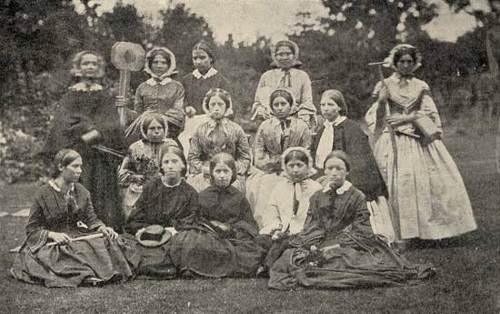
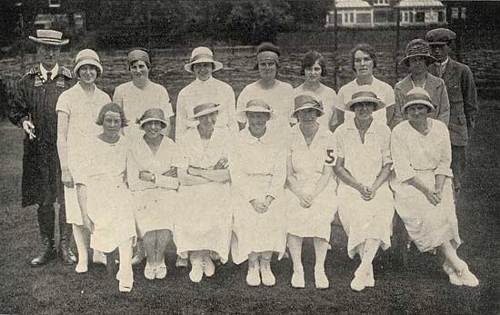
It was in the same year that Princess Louise, Duchess of Argyll, attended the famous match on the Sussex County Cricket Ground between the boys in blue from the Pavilion Hospital, “damaged by wounds,” and a team of ancient lawyers, “damaged by age.” The lawyers were beaten. A pleasing incident of the afternoon was the presentation to the Princess of a copy of one of Mrs Grantham’s books of poems containing the following inscription:
“Presented by gracious permission to Her Royal Highness Princess Louise, Duchess of Argyll, by the author’s husband in grateful recollection of Her Royal Highness’s presence at the Sussex County Cricket Ground on the occasion of the stoolball match between one-armed heroes of the Pavilion Hospital, Brighton, and Ye Ancient Lawyers.”
Her Royal Highness kindly permitted Mr Grantham to dedicate to her his book ‘Stoolball Illustrated and How to Play It’, which was, of course, the first and only book ever written on stoolball. Princess Louise was also present on that interesting occasion at Lord’s, in 1919, when a team from the Princess Louise Military Orthopaedic Hospital, Chailey, went up to London and defeated another team of veteran lawyers collected by Mr Grantham.
The first stoolball match at Lord’s was played in August 1917, when a London sports critic wrote:
“Sussex should be a proud county, for it originated a game which, after the lapse of four hundred years, has been so far recognised as to be played at Lord’s – that great playing ground with which is associated all that is famous in the greatest of our national sports.”
Not content with getting up teams to play the wounded men in the local hospitals, the “chieftain of the stoolball clan,” by his letters and articles in the London and local press, awakened interest up and down the country in the old Sussex game, and during 1917 and 1928 received over two hundred requests for books of rules.
Among his friends, whose name is legion, Mr Grantham raised a fund for providing stoolball sets for soldiers and sailors in hospitals all over England and abroad. Many letters have reached him so strangely addressed that the ingenuity of the Post Office authorities in discovering his identity and whereabouts is worthy of all praise.
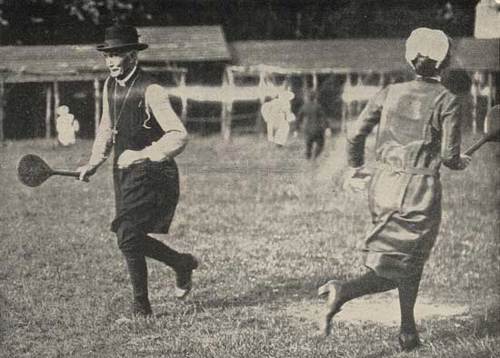
One could write pages about the interesting matches which have been played since the 1917 revival, at Lord’s and elsewhere, not the least memorable being that in which the Bishop of London captained a team from the Princess Louise Special Military Surgical Hospital, connected with the Chailey Heritage, and, on the breezy common, engaged Mr W W Grantham’s team.
The Duchess of Norfolk and Mrs Lloyd George have opened stoolball matches on the same ground, and among those who have excelled in the game are the late Mr Justice Grantham, General Sir Henry MacKinnon, the Hon Dame Maude Bevan, Mrs John Blencowe, the Misses Shiffner, Sir Albert Bosanquet, Miss Grace Cadman, Miss Curteis and Mr Ken Asoaka, and Mr K Yonezawa, of the Japanese Embassy.
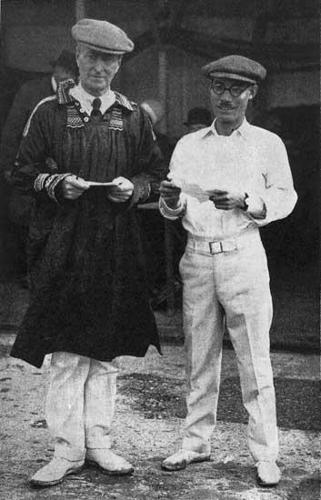
The Japanese Embassy team includes many good players whose interest in the game is undiminished. They enjoyed a practice match at Balneath Manor this year before their great match at the County Hall, London. In Ceylon the game has been played for some years by college students and others, and a stoolball match at Hillwood College, Kandy, with teams in the picturesque native dress is shown in these pages.
In Mr Grantham’s chat on stoolball given for the BBC a year or two ago he mentioned having played the game in Iceland, on the side of the railway in Siberia, in Finland, and in the Embassy Gardens at Tokyo. It is also played in France, Canada, Africa, Australia, and other countries.
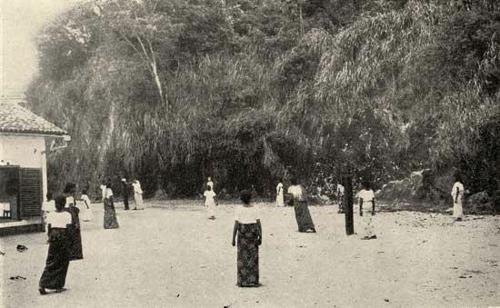
The 1917 revival, as will be seen, has become worldwide, while the institution, in 1923, of the Stoolball Association for Great Britain, with annual conferences held at Lord’s Pavilion, has placed the game on a sounder basis than it has ever enjoyed in its age-old history.
At the annual general meeting of the Stoolball Association for Great Britain, held at the County Hall on 7 May 1928, General Sir Henry MacKinnon presided. In the fourth annual report, presented on that occasion, it was stated that a modified form of the game had been introduced by the honourable secretary under the name of “stoolÂballette,” for three or four players a-side, and this can easily be played in racquet courts, barns, etc.
By kind permission of their Majesties the King and Queen, the usual parties have been held in the gardens of Buckingham Palace by the Not Forgotten Association, and many of the ex-soldiers enjoyed the game.
The latest reference the honourable secretary has received about the ancient game is as follows:
“1525. Item quod Petrus Frankeleyn VId posuit iiiixx oves in le Stoballfield contra ordinacionem hujus curiae antea factam.”
This is an interesting extract from the Rolls of the Court Baron of the Royal Manor of Kirklington, belonging to the Duchy of Lancaster, under the heading of Trepass, and is quoted in the Bodleian Quarterly Record, 15 November 1927. The honourable secretary (Mr W W Grantham) is always glad to receive old references to the game, as he has been asked to prepare a second and larger edition of ‘Stoolball Illustrated and How to Play It’.
Although the general revival of stoolball, with its amended rules, dates from 1917, there can hardly have been any time in the Grantham family when the game was not played. Mr. Justice Grantham played cricket at 70 and stoolball until he was 76. Three generations of the family played in a match at Lewes in 1909, when eight pairs of “trousers” played against ten “petticoats,” and it was on this occasion that Mr Ivor Grantham, eldest son of Mr and Mrs W W Grantham, played his first game, at the age of 12.
It is impossible to close these notes without a tribute to Mrs W W Grantham, who has supported her husband so nobly in his stoolball activities, and has not grudged the time devoted to the quest. In 1920 she worked the beautiful rich banner which is competed for annually by the teams of the East Sussex Elementary Schools Stoolball League. One knows she has encouraged her husband in wearing the smock, because she made, and smocked so beautifully, the garment in which he is seen at many of the matches.
The love of a simple country pastime, and the spirit of genial hospitality, have made new and happy chapters for the history of stoolball in Sussex. In 1917 people said of the revival that it was one of the few good things that came out of the war.
